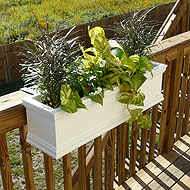Flower box
Flower box is a container used for growing decorative plants and flowers. Often found adorning windowsills, balconies, patios, and gardens, flower boxes add aesthetic appeal to homes and public spaces. They come in various materials, including wood, plastic, metal, and terracotta, each offering different benefits and challenges in terms of durability, maintenance, and appearance.
Types of Flower Boxes[edit | edit source]
Flower boxes can be categorized based on their placement and material:
Window Boxes[edit | edit source]
Window boxes are the most common type of flower box, designed to sit directly on or be hung beneath a window sill. They are an excellent way for apartment dwellers or those with limited garden space to enjoy a splash of color and nature.
Balcony Boxes[edit | edit source]
Balcony boxes are similar to window boxes but are designed to attach to balcony railings. They often come with adjustable fittings to accommodate different railing sizes.
Freestanding Boxes[edit | edit source]
Freestanding boxes are larger and can be placed on the ground. They are suitable for patios, decks, or garden paths, allowing for the creation of miniature gardens in areas where soil conditions are poor.
Materials[edit | edit source]
The choice of material for a flower box can affect its longevity, maintenance needs, and how it complements the building or landscape.
Wood[edit | edit source]
Wooden flower boxes are popular for their natural appearance. However, they require regular maintenance to prevent rot and decay, especially when made from non-resistant species.
Plastic[edit | edit source]
Plastic flower boxes are lightweight, affordable, and come in various colors. They are resistant to weathering and require little maintenance but may not be as durable as other materials over time.
Metal[edit | edit source]
Metal flower boxes, made from aluminum, iron, or galvanized steel, offer durability and a modern look. They can withstand harsh weather conditions but may require treatments to prevent rust.
Terracotta and Ceramic[edit | edit source]
Terracotta and ceramic flower boxes are heavy and fragile but provide a classic and elegant appearance. They are excellent for moisture retention, benefiting plants that require consistent watering.
Planting in Flower Boxes[edit | edit source]
Choosing the right plants for a flower box depends on the box's location and the amount of sunlight it receives. Common choices include:
- Annuals, such as petunias and marigolds, for bright, seasonal color
- Perennials, like succulents and herbs, for year-round interest
- Edible plants, such as strawberries and lettuce, for practical and decorative purposes
Proper drainage is crucial to prevent root rot. Many flower boxes come with pre-drilled drainage holes, but additional holes may need to be added. Using a high-quality potting mix ensures adequate nutrients and moisture retention.
Maintenance[edit | edit source]
Regular watering, fertilizing, and deadheading (removing spent flowers) are essential for the health and appearance of flower box plants. The specific care requirements will vary depending on the types of plants grown.
Environmental Impact[edit | edit source]
Flower boxes can contribute positively to the environment by supporting pollinators such as bees and butterflies. They also help improve air quality and can reduce urban heat island effect by adding greenery to concrete-dominated areas.
Search WikiMD
Ad.Tired of being Overweight? Try W8MD's physician weight loss program.
Semaglutide (Ozempic / Wegovy and Tirzepatide (Mounjaro / Zepbound) available.
Advertise on WikiMD
|
WikiMD's Wellness Encyclopedia |
| Let Food Be Thy Medicine Medicine Thy Food - Hippocrates |
Translate this page: - East Asian
中文,
日本,
한국어,
South Asian
हिन्दी,
தமிழ்,
తెలుగు,
Urdu,
ಕನ್ನಡ,
Southeast Asian
Indonesian,
Vietnamese,
Thai,
မြန်မာဘာသာ,
বাংলা
European
español,
Deutsch,
français,
Greek,
português do Brasil,
polski,
română,
русский,
Nederlands,
norsk,
svenska,
suomi,
Italian
Middle Eastern & African
عربى,
Turkish,
Persian,
Hebrew,
Afrikaans,
isiZulu,
Kiswahili,
Other
Bulgarian,
Hungarian,
Czech,
Swedish,
മലയാളം,
मराठी,
ਪੰਜਾਬੀ,
ગુજરાતી,
Portuguese,
Ukrainian
Medical Disclaimer: WikiMD is not a substitute for professional medical advice. The information on WikiMD is provided as an information resource only, may be incorrect, outdated or misleading, and is not to be used or relied on for any diagnostic or treatment purposes. Please consult your health care provider before making any healthcare decisions or for guidance about a specific medical condition. WikiMD expressly disclaims responsibility, and shall have no liability, for any damages, loss, injury, or liability whatsoever suffered as a result of your reliance on the information contained in this site. By visiting this site you agree to the foregoing terms and conditions, which may from time to time be changed or supplemented by WikiMD. If you do not agree to the foregoing terms and conditions, you should not enter or use this site. See full disclaimer.
Credits:Most images are courtesy of Wikimedia commons, and templates, categories Wikipedia, licensed under CC BY SA or similar.
Contributors: Prab R. Tumpati, MD

